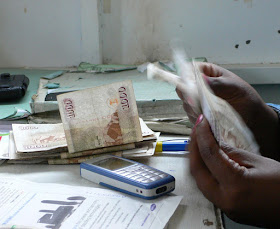by Daivi Rodima-Taylor and Bill Maurer in NextBillion
 |
| Kuria cash contribution group in Tarime highlands, Tanzania. |
We are in the middle of the “fintech age,” a time of rapid development and adoption of new financial and payment technologies worldwide. The spread of fintech is not just touching more lives; it is bringing those users, and their relations, directly into the realm of finance.
The impacts of this transformation range from exciting to troubling. To take just one example, digital payment infrastructures spreading in the Global South make visible the digital footprints of billions of people who have not been part of the formal sector. On the one hand, this is making credit available to customers who’ve long lacked access – but on the other, it may bring along exploitative “
dataveillance” and over-indebtedness.
Whatever their impacts, fintech initiatives in emerging markets often build on interpersonal patterns of mutuality, fostering and capturing diverse “sharing economies” and
bringing the affective into the purview of formal finance. In other words, these initiatives tend to harness existing community networks and informal methods of transacting, aiming to reflect or replicate their dynamics through formal products.
The interaction of local informal institutions and norms with formal digital finance initiatives is particularly pronounced in the Global South. But these interpersonal dynamics are vastly underexplored, and their significance underestimated. We argue that fintech endeavors in the payments and remittances space tend to overlook how their efforts are mediated and adapted by local gatekeepers. These gatekeepers may range from mobile money agents to neighborhood shopkeepers, and they mitigate the diverse risks of money transfer, and direct the new resources into socially acceptable pathways.
Put simply, we often err in assuming a remittance is a person-to-person transfer. Often, it’s a person-to-intermediary-to-person transfer (sometimes with several intermediaries along the way). Intermediaries fulfill a host of functions for the end points of a transfer, serving as guides, translators, helpers and guardians of values beyond the economic. Understanding these roles has implications for service design – in this article, we’ll examine them in more detail.
The Role of Gatekeepers – and the Meaning of Money
International and domestic remittances remain central to the livelihoods of many households globally. Officially recorded global remittance flows have nearly doubled over the past decade, growing from US $380 billion in
2007 to US $689 billion in
2018. They constitute the largest foreign capital inflows to many world regions.
Our recent research shows that the remittance infrastructures in the digital age – including mobile and digital currencies, “traditional” remittance companies like Western Union, and other fintech players – are best seen as multi-level, fragmented and overlapping assemblages of diverse pathways. These pathways often include monopolistic companies like Moneygram (which provides cross-border remittances) and Safaricom (which distributes Moneygram remittances via mobile money transfers in-country). These different networks are kludged together and mediated at their connection points by diverse social and institutional gatekeepers. These gatekeepers may include local mobile money agents, informal savings groups and alternative moneylenders, and also retail shops and
pawnbrokers that facilitate remittances – all of whom often help traverse the “last mile” to end-users.
 |
| Mobile money agent in Gulu, North Uganda. |
These gatekeepers often become part of the “story” behind the funds they help distribute, as these seemingly interpersonal money flows are actually an important
repository of meaning and social markers. That is, the money carries social and moral commentary while chronicling people’s daily lives and trajectories, reflecting the memories and intentions of individuals and their social networks. For example,
money gifts may mark human relationships and celebrate temporal cycles, such as the
hong bao of the Chinese New Year – red envelopes containing money, exchanged among friends and relatives. Not surprisingly, the payment function of China’s ubiquitous messaging app, WeChat, only gained traction when it let people send each other digital
hong bao, thus harnessing existing cultural beliefs and practices around money.
To grasp why it’s so important to understand the different cultural meanings behind money flows, consider the
Kuria people of northeast Tanzania. In this community, informal agricultural labor sharing groups draw on longstanding norms of reciprocity, and have morphed into cash mediators in modern money transactions. These mediators fulfill the role of safely and morally bringing outside flows of money to those inside the group. Their role is consistent with Kuria cosmology, which highlights a constant mediated interchange with the outside, using the metaphor of the “throat” or “windpipe” (omooyo) for transactional pathways.
Consider how this is similar to and different from
hong bao. To the Chinese, these red envelopes signify luck and protection against evil spirits, whereas to the Kuria, omooyo signifies the pathways that connect inside and outside. Designers of digital money systems have an easier time adopting cultural practices like
hong bao, which can be easily seen, than social relationships like those represented by omooyo, which are difficult to detect unless you are enmeshed in them. Therefore, when users report on surveys that they use mobile money for something like “school fees,” for example, a product designer needs to look a little deeper to see through whose hands and phones the money actually passes along the way to its destination, and what relationships are activated in the process. This may reveal insights like those found in
western Kenya, where “school fees” payments frequently take an important detour through coming-of-age rituals that stitch together city, country and kin.
The Importance of Local Intermediaries
In African societies, the role of marking and channeling any new resources has long been performed by informal mutual support groups and peer networks like the Kuria labor-sharing groups. These groups remain
important actors in channeling e-money in modern-day mobile money systems. They help redistribute and circulate money along their established social networks, based on reciprocity and mutual obligation.
But the effects are sometimes contradictory. In some instances, mobile money networks can facilitate resource pooling and sharing among extended kin and peer groups – and this can foster new connections. In other cases, the availability of digital remittances can lessen interpersonal contacts and weaken social and family ties, as it eliminates the need for physical travel, in-person meetings and visits back home. Yet, in still other cases, the weakening of some ties can strengthen others: Removing physical distance and travel can facilitate women’s networks separate from men’s, which can mobilize resources to support the women’s goals—for instance, in subverting male elders’ choice of one marriage partner over another.
For these reasons, providers should focus substantial attention on such intermediaries, including the mobile money agents – or “cash merchants” – who buy and sell e-money. They are crucial to the cash-in, cash-out process of using mobile money – but in many emerging countries, they do much more. Many are local shopkeepers, part-time retailers and hawala remittance distributors. They have their own embedded systems of relational contracting and social expertise. They are not, in other words, mere “human ATMs,” but rather they interject their social relationships into transactions to facilitate their customers’ actual intended goals (holding e-money or cash for them for a time, assisting with bill payment, and providing financial advice or loans). Hence, agents do not just facilitate transfers, but broker and redistribute remittance flows. Mobile money companies may try to break these old habits, but in trying to do so, they also make their service less valuable to the people who want to use it to facilitate all the things an intermediary can accomplish for them.
Bringing Intermediaries into Focus
Diverse human and social intermediaries in local communities are thus important elements in emerging
digital infrastructures. Bringing into contact different recording devices, accounting practices, and purposes and intentionalities, these local gatekeepers
transform and co-create the payments infrastructures. As they cut into these interpersonal exchange networks, digital payment platforms act as novel interfaces between formal and informal economies.
A focus on the social relations of digital payment infrastructures enables us to see what is obscured by the seeming neutrality or seamlessness of the technology. In an age where digital infrastructures
increasingly leverage futuristic technologies like self-learning algorithms and smart contracts, it is particularly important to remember that “old fashioned” social intermediaries often play a central role in their adaptation and use. Designing systems with intermediaries in mind from the beginning, not as passive pass-through points but active brokers, might enable such technologies to get further reach without sidelining the human interconnections people often use money flows to forge and maintain.
Daivi Rodima-Taylor is an anthropologist and Africanist at the Frederick Pardee School of Global Studies, Boston University, and Visiting Researcher at University of California, Irvine.
Bill Maurer is Professor of Anthropology and Law, University of California, Irvine, and Director of the Institute for Money, Technology, and Financial Inclusion (IMTFI).
Photo credits: Daivi Rodima-Taylor.
View original post on NextBillion:
https://nextbillion.net/fintech-local-networks-remittances/

































